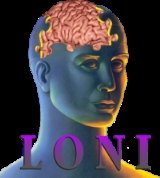
Laboratory Of Neuro Imaging
Encyclopedia
The Laboratory of Neuro Imaging (LONI) is a research laboratory within the Department of Neurology at the UCLA David Geffen School of Medicine. The laboratory conducts a wide variety of brain imaging studies of normal brain anatomy and function, development, aging, and disease. Historically, research at LONI has focused on design, development, validation and wide dissemination of software tools for use in understanding the relationships between brain structure and function across space, time and scale. In particular, work has been conducted toward the construction of multidimensional brain atlases seeking to promote computationally efficient representations of brain anatomy, function and physiology in a standardized 3D coordinate system. Brain imaging modalities include MRI, fMRI, Diffusion Tensor Imaging, Magnetic Resonance Spectroscopy, Positron Emission Tomography
, Optical Intrinsic Signal, among other means for gathering spatially-based neurophysiological signals.
Positron emission tomography
Positron emission tomography is nuclear medicine imaging technique that produces a three-dimensional image or picture of functional processes in the body. The system detects pairs of gamma rays emitted indirectly by a positron-emitting radionuclide , which is introduced into the body on a...
, Optical Intrinsic Signal, among other means for gathering spatially-based neurophysiological signals.
Resources
The Laboratory of Neuro Imaging has deployed a comprehensive infrastructure for conducting advanced neuroimaging and brain mapping research. This infrastructure is based on the following types of resources:- Software: LONI faculty and staff work to develop efficient computational algorithms and software for the quantitative mapping of brain structure and function.
- Scientific Data Workflows: the development of process oriented algorithms and meta-algorithms for assessing neuroimaging and other biologically-relevant data sets. See LONI PipelineLONI PipelineThe LONI Pipeline is a distributed system for constructing, validating, executing and disseminating scientific workflows on grid computing architectures. A major difference between this and other workflow processing environments is that the LONI Pipeline does not require new tools and services to...
for overview. See also discussions of Scientific Data Provenance. - Databases: The LONI Image Database was developed to provide a flexible and effective interfaces for managing, archival and protection of neuroimaging data.
- Computational resources: Through a collection of complementary NIH grant mechanisms, LONI has sought to provide high-end computational servers, storage and networking facilities, which include Grid server, Gigabit network, Data Immersive Visualization Environment (DIVE) as well as brain tissue preparation, genetics, and microscopy laboratory space.
Research
Examples of the brain mapping research conducted at LONI include:- Alzheimer's disease: Investigating structural, functional, metabolic and pathological changes triggered by Alzheimer's diseaseAlzheimer's diseaseAlzheimer's disease also known in medical literature as Alzheimer disease is the most common form of dementia. There is no cure for the disease, which worsens as it progresses, and eventually leads to death...
. LONI research focuses on characterizing the timecourse of pathology in the AD brain. - Normal brain development and neurodevelopmental disorders: LONI development efforts have focused on assessing structural brain changes by mapping anatomical growth and pruning associated with both normal and abnormal brain development during childhood and adolescence.
- Optical Intrinsic Signal Imaging: Mapping the brain by measuring intrinsic activity-related changes in tissue reflectance.
- SchizophreniaSchizophreniaSchizophrenia is a mental disorder characterized by a disintegration of thought processes and of emotional responsiveness. It most commonly manifests itself as auditory hallucinations, paranoid or bizarre delusions, or disorganized speech and thinking, and it is accompanied by significant social...
: Mapping heritability and effects of risk genes on structural features in the brain. - Atlasing of the C57BL/6J mouse brain
- Neuronal white matter tract tracing in the mouse
- Mathematical modeling
- Neuroscience databasing
- Applications of Grid computingGrid computingGrid computing is a term referring to the combination of computer resources from multiple administrative domains to reach a common goal. The grid can be thought of as a distributed system with non-interactive workloads that involve a large number of files...
in the neuroscienceNeuroscienceNeuroscience is the scientific study of the nervous system. Traditionally, neuroscience has been seen as a branch of biology. However, it is currently an interdisciplinary science that collaborates with other fields such as chemistry, computer science, engineering, linguistics, mathematics,...
s

